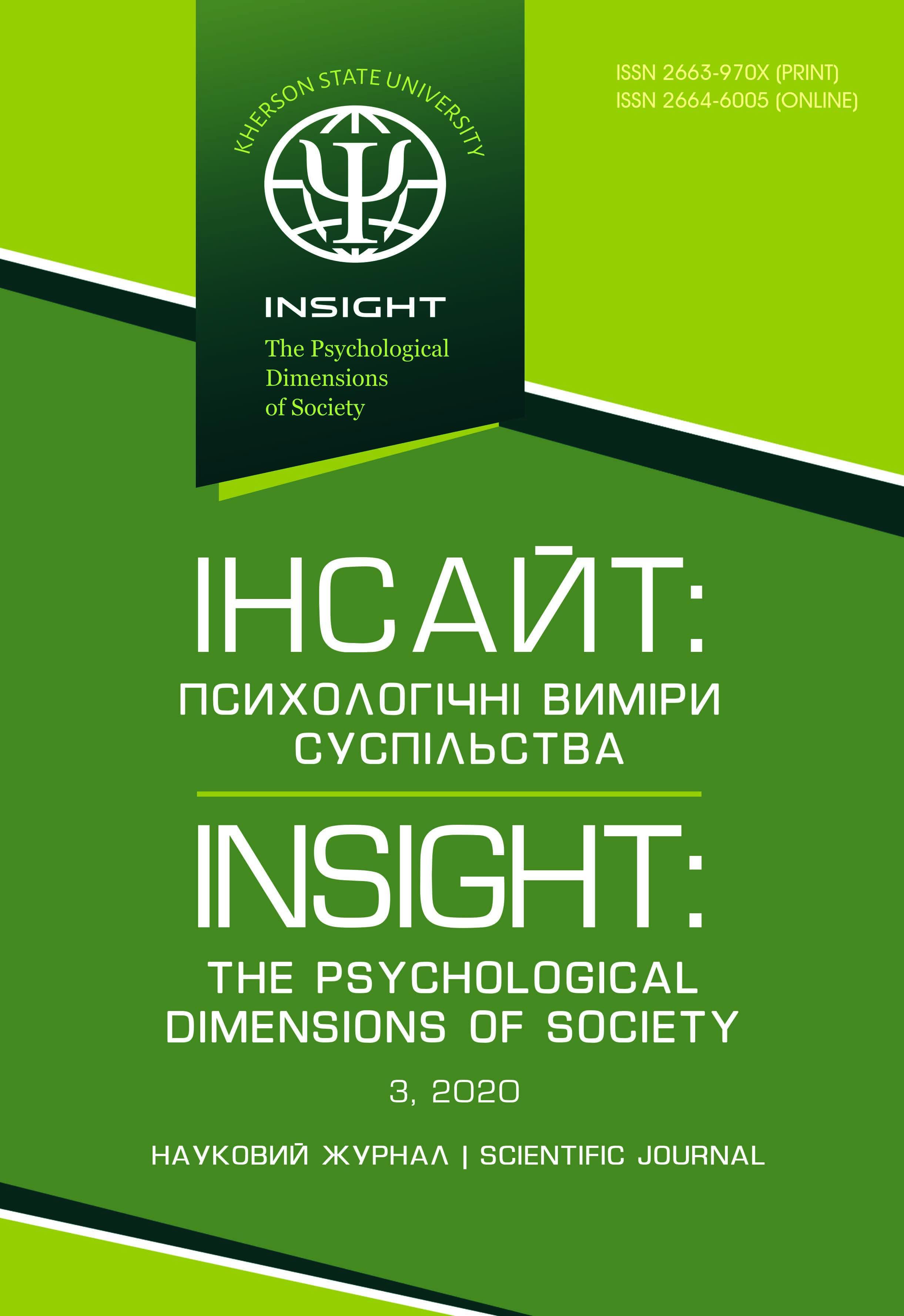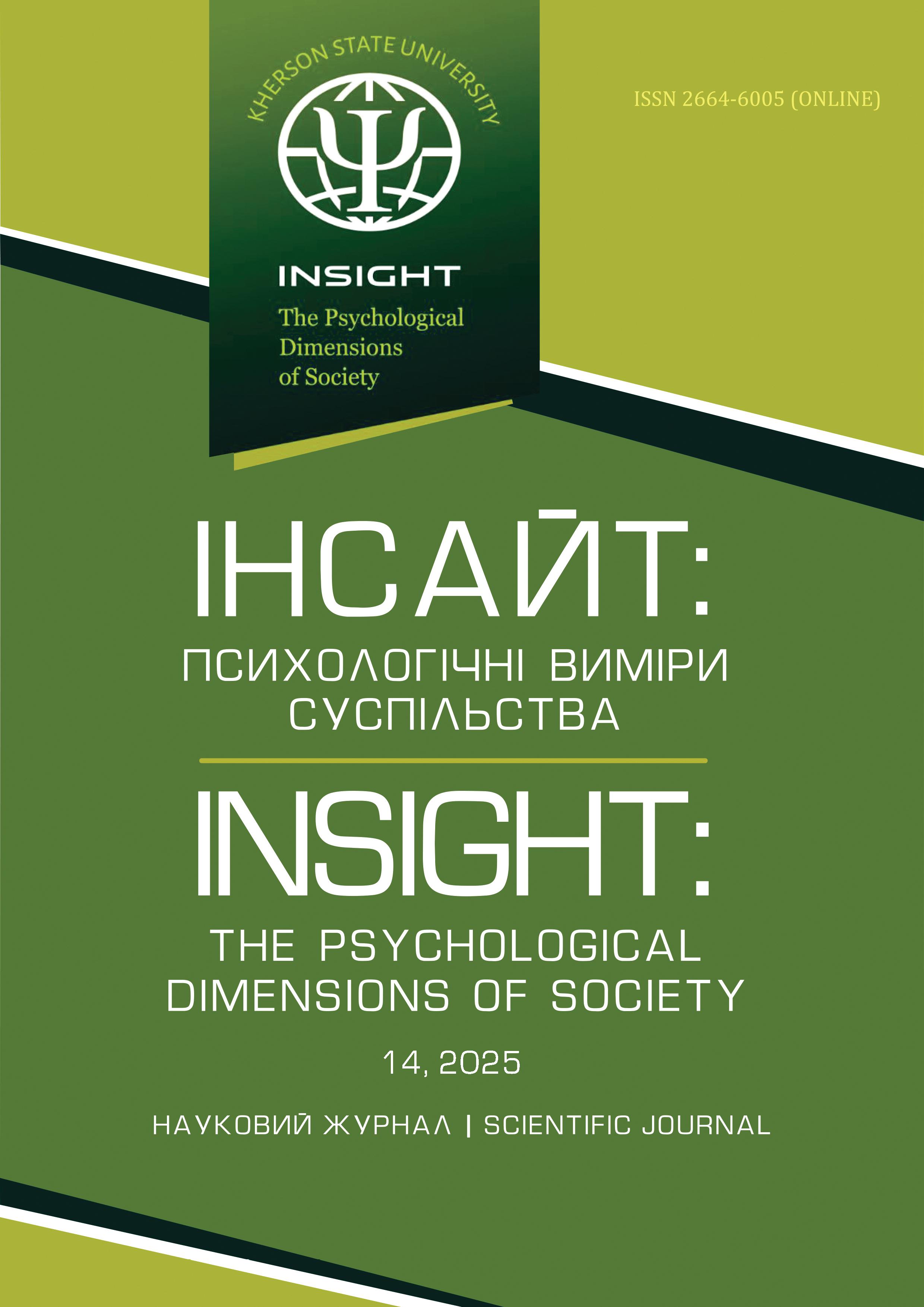The features of the influence of urban identity on the social and psychological adaptation of students
Abstract
The purpose is to clarify the influence of the level of maturity of the urban identity on the social and psychological adaptation of students and satisfaction with life. Methods. The following methods were used in the empirical research: Urban Identity Questionnaire (S. O. Litvinova, O. I. Muravyova); Questionnaire of Social and Psychological Adaptation (C. Rogers & R. Diamond, adapted by O. K. Osnytsky); The Satisfaction with Life Scale of E. Diener adapted by D. O. Leontiev, Ye. M. Osin). Results. The article includes different theoretical viewpoints and scientific approaches to the substantiation of the concept “urban identity”. The structure of urban identity consists of cognitive, emotional and behavioral-regulatory components. The research shows the influence of mature identity on the social adaptation under urban conditions. The authors make the social and psychological analysis of differences between the urban and countryside lifestyles; they find out that urban lifestyle is based on a high spatial, professional and social mobility of urbanites. It is emphasized that urban identity has an axiological and logical nature as it sets norms and rules, which regulate human behavior while actualizing in different situations of social interaction. The empirical research clarified the features of the manifestation of students’ urban identity, its influence on the social and psychological adaptation of students, carries out a comparative analysis between a group of students who are original residents of the city and a group of students who moved into the city from the countryside to study at the university. Conclusions. The findings of the empirical research confirm the differences in terms of the social and psychological adaptation between the group of “urbanites”, i.e. students who were born and live in the city and the group of “country people” who moved into the city to study at the university. By using the correlation analysis, the authors prove the interdependence between the level of maturity of urban identity of students (cognitive, emotional and behavioral-regulatory components) and progress of social and psychological adaptation in the city. The research prospects are the development of means of psychological aid for the adaptation of students who come to the city to study at the higher education institutions.
Downloads
References
2. Баранова В. А. Городской и сельский социумы: социально-психологические аспекты исследования территориально-поселенческих общностей. Вестник СПбГУ. Сер. 12. 2012. Вып. 2. С.194–201.
3. Belanche D., Casalуs L. V., Flaviаn C. Understanding the cognitive, affective and evaluative components of social urban identity: Determinants, measurement, and practical consequences. Journal of Environmental Psychology. 2017. Vol. 50. P. 138–153. DOI: https://doi.org/10.1016/j.jenvp.2017.02.004
4. Bernardo F., Palma-Oliveira J. M. Place identity, place attachment and the scale of place: the impact of place salience. Psychology. 2013. Vol. 4. P. 167–193. DOI: https://doi.org/10.1080/21711976.201 3.10773867
5. Blynova, O. Ye, Popovych, I. S., Bokshan, H. I., Tsіlmak, O. M. & Zavatska, N. Ye. (2019). Social and Psychological Factors of Migration Readiness of Ukrainian Students. Revista ESPACIOS, Vol. 40. (№ 36). Page 4. .http:// www.revistaespacios.com/a19v40n36/19403604. html
6. Блинова Е. Е. Психологические аспекты адаптации сельских жителей к условиям городской среды. Актуальные проблемы психологии личности и социального взаимодействия : сб. науч. ст. / ГрГУ им. Я. Купалы ; науч. ред.: А. В. Ракицкая, О. Г. Митрофанова. – Гродно : ГрГУ, 2018. C.24-31.
7. Dias P., Ramadier T. Social trajectory and socio-spatial representation of urban space: The relation between social and cognitive structures. Jour¬nal of Environmental Psychology. 2015. Vol. 41. P. 135–144. DOI: https://doi.org/10.1016/j. jenvp.2014.12.002
8. Дягилева Н. С., Журавлева Л. А. Городская идентичность: понятие, структура, основы. Социология города. 2012. № 1. С. 46–61.
9. Губеладзе І. Г. Сільська молодь у місті: пошук ідентичності : монографія. К. : Міленіум, 2015. 236 с.
10. Литвинова С. А., Муравьева О. И. Опросник идентичности с городом: разработка, валидизация, проверка надежности. Вестник Новосибирского государственного педагогического университета. 2018. Том. 8. №1. С. 71–93. DOI: 10.15293/2226-3365.1801.05
11. Микляева А. В., Румянцева П. В. Соотношение центральных и периферических компонентов в структуре социальной идентичности личности. Психологический журнал. 2011, том 32, № 5, С. 36–45.
12. Милграм С. Эксперимент в социальной психологии. СПб. : Питер, 2000. 336 с.
13. Осин Е. Н., Леонтьев Д. А. Апробация русскоязычных версий двух шкал экспресс-оценки субъективного благополуччя. Материалы III Всероссийского социологического конгресса. М.: Институт социологии РАН, Российское общество социологов, 2008. [Диск CD, ISBN 978- 6- 89697-157-3.]
14. Осницкий А. К. Определение характеристик социальной адаптации. Психология и школа. 2004. № 1. С. 43–56.
15. Штейнбах Х. Э., Еленский В. И. Психология жизненного пространства. СПб. : Речь, 2004. 239 с.
16. Ujanga N., Zakariya K. The notion of place, place mean¬ing and identity in urban regeneration. Procedia – social and behavioral sciences. 2015. Vol. 170. P. 709–717. DOI: http://dx.doi.org/10.1016/j. sbspro.2015.01.073
17. Завацька Н. Є. Соціокультурні та психологічні аспекти адаптації особистості в сучасному соціумі: монографія / Під ред. Н. Є. Завацької. Луганськ: Вид-во ім. В. Даля, 2012. 320 с.
Authors who publish with scientific journal agree to the following terms:
• All scientific papers may be freely copied and distributed on any medium and in any format, provided that the references to the initial data of the scientific work are indicated.
• Authors retain copyright and grant the journal right of first publication with the work simultaneously licensed Creative Commons Attribution License .
• Authors are able to enter into separate, additional contractual arrangements for the non- exclusive distribution of the journal’s published version of the work (institutional repository, your website, monograph), with an acknowledgement of its initial publication in this journal.





































